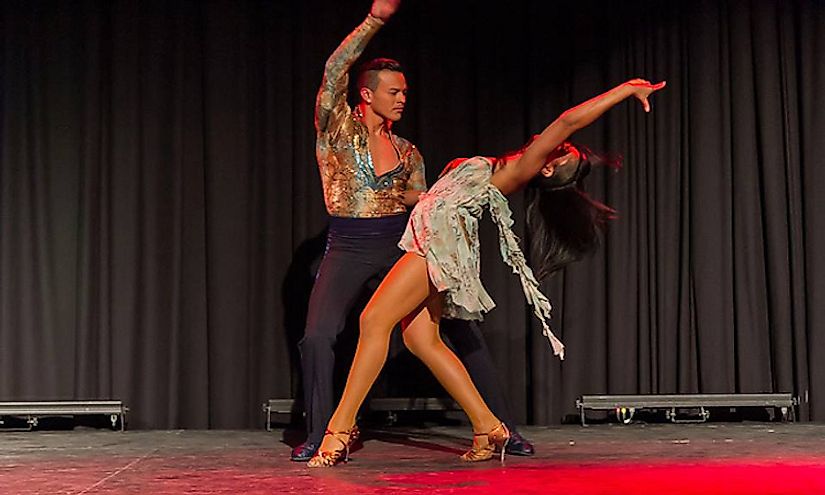The Buzz on Dance San Francisco
Table of ContentsNot known Incorrect Statements About Dance San Francisco Not known Factual Statements About Dance San Francisco 7 Simple Techniques For Dance San FranciscoGetting The Dance San Francisco To Work
Allow's think of Salsa dance and music as a huge Tree that resembles this: Salsa is danced worldwide while several technological facets of the dancing coincide throughout designs (6 steps over 8 beats danced on a quick-quick-slow or slow-quick-quick rhythm), there are numerous "hallmark" attributes of the main styles of Salsa that differentiate one from the other.Pairs joining a Casino site Rueda dance all relocate unison as called by a Leader. Distinct features of Cuban design salsa are round turn patterns (with "break back" actions on counts 1 and 5) as well as body activity inspired by typical Afro-Cuban folkloric dances. Distinguishing attributes of Cali design salsa is fast and detailed footwork, danced with a solid hand hold link in between partners.
The beginnings of the design are a topic of dispute, yet it is said that New York design Salsa dance originated in the 1960's as a result of the influx of Latin American emigrants after the Cuban Change (salsa dancing sf). Eddie Torres is one of the most well known New York design professional dancer, being almost generally attributed with popularizing the style to dance centres outside of New york city
The standard rhythm of "On-2" is slow-quick-quick. The "youngest" of the designs of Salsa, L.A (https://myanimelist.net/profile/dancesf). Style (some individuals have actually called it "West Coast" design) ended up being prominent in the 1990's and has its beginnings in ballroom (Mambo, Swing and Cha, Cha, Cha). Turn patterns lead and adhere to methods are greatly influenced by these designs, with the Cross Body Lead being the cornerstone of the design
The Only Guide to Dance San Francisco
Design are execution of turn patterns and figures in the "port", with the break actions on counts "1" and "5". This design is additionally identified by elegant and commonly complex arm styling by the follow to accent the "1" and "5" matters. The fundamental rhythm of "On-1" is quick-quick-slow. While Salsa music has solid origins in Cuban, Colombian and Puerto-Rican folkoric traditions, it can not be marked down that all Afro-Latin and Latin American societies have added to contemporary Salsa songs as we understand it today.


The 25-Second Trick For Dance San Francisco
distinguishing qualities of Salsa songs are: 4/4 time signature, Child Clave and Tumbao rhythms, Montuno Piano Unless you have a history in songs, the above 3 qualities possibly imply absolutely nothing to you. An easier way to explain Salsa songs is just how it does NOT seem like various other sorts of Latin American music.

Most brand name brand-new professional dancers pick to find out L.A. "On-1" style slotted Salsa styles are the most prevalent in North America (with some exemptions of some metropolitan centres that still primarily embrace Cuban and Puerto Rican styles) and L.A
The Facts About Dance San Francisco Revealed
.A. https://dancesf9.wordpress.com/. Style will quickly teach you the fundamentals of Salsa timing, weight transfer and turn pattern transform. Several professional dancers, when they've had a year or two of dancing L.A. Style Salsa under their belts, "button" to New York design in order to expand their dance vocabulary; however many dancers choose to stick to simply one style of Salsa and appreciate their time on the dance flooring in that certain design.
Style and New York City Design all being danced in the exact same club, with a number of the professional dancers having the ability to change from one style to the various other from one tune to the next. salsa dancing sf. No matter which style you choose it is necessary to stick to that design until you're really comfortable with the fundamentals of timing, body rhythm and structure relocation try this site implementation before thinking about "changing" styles (if you wish to)
As soon as you begin on lessons prepare to devote time and energy to finding out exactly how to dance as a whole it takes a full novice (i. e., someone with little or no dancing experience) regarding 6 months of proactively taking lessons and going out and practicing at the very least two times a week to reach a point where pattern execution begins to really feel "all-natural".